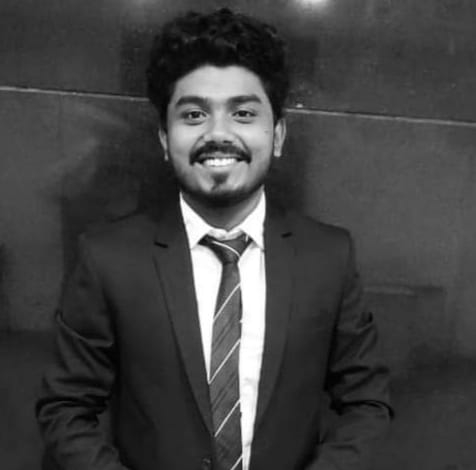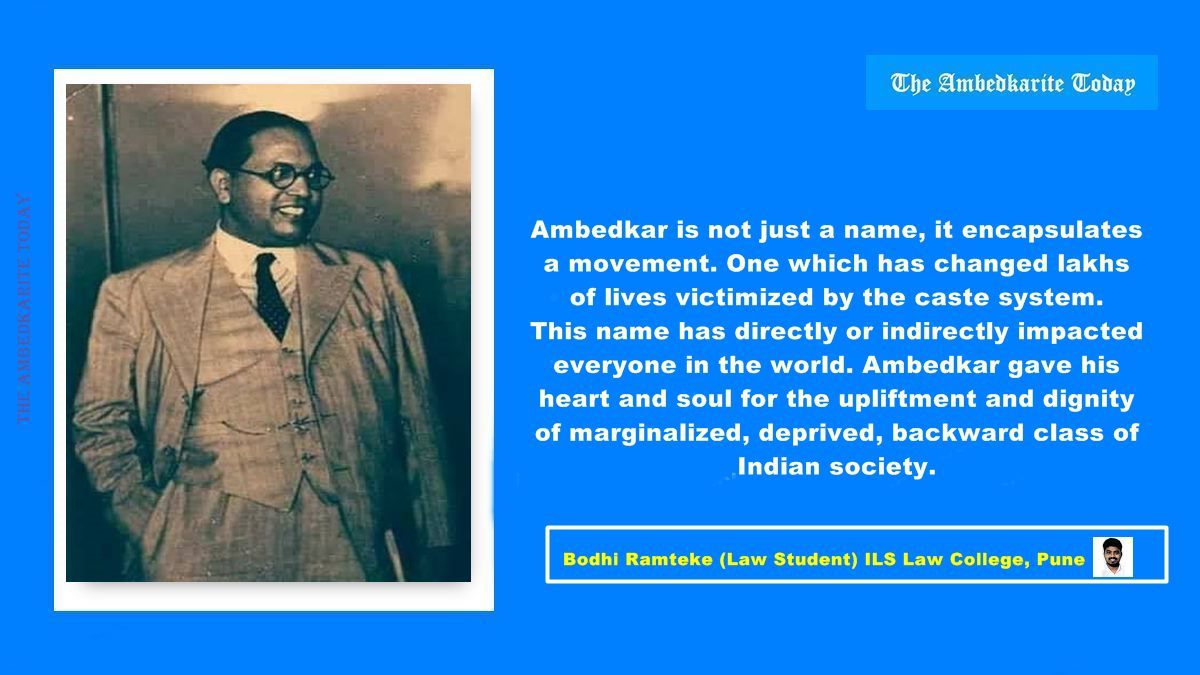Ambedkar is not just a name, it encapsulates a movement. One which has changed lakhs of lives victimized by the caste system. This name has directly or indirectly impacted everyone in the world. Ambedkar gave his heart and soul for the upliftment and dignity of marginalized, deprived, backward class of Indian society.
Today, many are taking forward Dr. Ambedkar’s movement with an honest vision for societal change. But for some this name is just to fill their vote bank.
Dr. B.R Ambedkar contributed his life for the reconstruction of society and to form Modern India. He is called the hero of Dalits, and indeed he is. However, one has to understand that his work in not only limited to the upliftment of Dalits, but also to every sector and section of the society. Ambedkar was not just a Dalit leader. He was surely above this categorization. Behind all his work he had one main motive that is ‘Annihilation of Caste’ because he identified that it was the only root cause of all problems Through this article I want to highlight the various aspects of Versatile Ambedkar
Dr. Ambedkar as a Journalist
Every section of the society should get representation in media otherwise there will be spread of unbalanced and one-sided information in society. Dr. Ambedkar said that, that section of society which has been consciously deprived from representation should open their own media by which they can express, portray and display their problems. Dr. Ambedkar thus enters the world of journalism, to reveal the rebellion of voiceless people, to discuss and put forth the problems of the deprived class of the society. On 31st January 1920 started the fortnightly, ‘Mooknayak’, which translate to the “Hero of voiceless”. It was the effective medium to get remedies and solutions to fight against injustice. Through Mooknayak, Dr. Ambedkar started a movement.
Rajashri Shahu Maharaj himself visited Babasaheb in his chawl in Mumbai and offered a donation of 2500 to start ‘Mookknayak’. This magazine ran for 3 years and then in 1923 Babasaheb went abroad. After returning back in 1927 on 3rd April he started a new fortnightly named ‘Bahishkruth Bharat’, which means ‘Excluded India’.
When he started it, it was the time of Mahad Satyagraha. He set forth various important topics in Bahishkruth Bharat. In 1927, the most discussed topic was the marriage of a Hindu girl, ‘Malinibai Panandikar’ and a Muslim man, ‘Gulabkhan Bashiruddhinkhan’. Various newspaper publishing from Pune opposed this wedding. But Dr. Ambedkar wrote a passionate article in ‘Bahishkrut Bharat’ on 1 May 1927 in support of that marriage. He said that just as to annihilate the caste there is a need of intercaste marriages, in order to break casteism between Hindu and Muslims, interfaith marriage should be encouraged. While criticising opponents of the interfaith marriage, he argued that marriage was a personal matter, in which outsiders play no role. He also quoted Dr. Ravindranath Tagore about his thoughts on inter caste marriage.
He has written on child marriages, temple entry Movement, Satyashodhak Movement, Simon Commission and Labor Party, amongst others.
In 1930 he started ‘Janta’. Dr. Ambedkar was directly involved in the editorial management of the first two fortnightly i.e., Muknayak and Bahishkrut Bharat. After 1930 he passed on the responsibility to his colleagues, Devrao Naik, B.R. Kadrekar, G.N. Sahastrabuddhe, R.D. Bhandare, and B.C. Kamble. After taking Dhamma Diksha and converting into Buddhism in 1956, he changed the name of Janta to ‘Prabuddha Bharat’.
Dr. Ambedkar has different views about Advertisement. Newspapers can’t run without Advertisement. Dr. Ambedkar said that though advertising is required for financial support, should newspapers always go for advertising? Instead, he suggested, a code should be followed by the newspaper regarding the publication of Advertisement.
With such different aspect and views regarding journalism, Dr. Ambedkar used media as a powerful medium for societal change.
Farmers Affectionate Ambedkar
Dr. Ambedkar’s views dealing with agriculture are pivotal in economics. He was the first person to introduce the bill to abolish ‘Khoti System’ (The hierarchical system floated by the British to collect tax by granting huge power to a powerful person of a locality who were titled as Khots. With time, Khots emerged as a powerful and influential middleman who was brutally trained to collect land revenues for the empire.) District Farmers Council organised in Chiplun Dist. Ratnagiri on 14th April 1929 was chaired by Dr. Ambedkar. From then, he started a movement against Khot System in Konkan Region and later in 1930, he introduced a Bill against it and on 10 January 1930, he convened a march of 25000 farmers to the Parliament. Farmers from Konkan region, Satara, Nashik and other part of Maharashtra took part in that march.
One of the most important schemes planned by Dr. Ambedkar on agriculture is the Damodar Project
He wanted to use that water for agriculture, and to generate electricity and start water transporting. Along with Damodar Valley project, he initiated the Bhakra Nangal Dam project, the Son River Valley project and Hirakud dam project. He also established the Central Water Commission to facilitate the development of irrigation projects at both the Central and the state level.
He gave a radical solution of nationalisation of land and the cultivation of farm as a collective farm.
He made plans based on the objective of inclusive development from person to nation. From time to time, Babasaheb had said that farmers and laborers should be organized so as not to compromise on the rights of agriculture and farmers.
Women’s liberation and Dr. Ambedkar
To understand the root of Caste System and Untouchability, Dr. Ambedkar studied and critically analysed all religious scripture and concluded that they are the root cause of both menaces. In the thesis ‘Caste in India: Their Mechanism, Genesis and Development’ submitted by Dr. Ambedkar in Anthropology Dept. of Columbia University, he explained that the origin of the inhuman practices towards women is hidden in the caste system. Patriarchal system in India is responsible for the inferior or secondary status of women. Women were not considered fit for spiritual attainment. All the books of Hindus including Manusmriti have very distinctly written about their degraded status. Dr. Ambedkar, in opposition to this degradation, burnt the Manusmriti on 25 December 1927 and started the movement for women’s liberation.
By taking this movement forward he introduced the ‘Hindu Code Bill’ on 21st September, 1951 which sought to enshrine gender equality in the laws of inheritance and marriage. But the Brahmanical and patriarchal mentality opposed the bill and consequently, Parliament stalled his draft of the Hindu Code Bill. For this reason, Dr. Ambedkar resigned from the Cabinet as Law Minister.
The Hindu Code Bill stated that property including both movable and immovable property should be acquired by a woman. The acquisition of property should be made by a woman before and after marriage even during the widowhood from her parents or husband. Dowry would be paid as a condition and consideration. The share of the property of each unmarried daughter shall be half that of each son and the share of each married daughter shall be one-quarter of that of each son. Hindu Code Bill was divided into three major parts, i) right to property, ii) order of succession to the property, iii) maintenance, marriage, divorce adoption, minority and guardians. Later in 1955, the laws relating to marriage, adoption, maintenance, divorce etc. were passed in parliament inspired by Amedkar’s original Hindu Code Bill.
Labor Welfare and Dr. Ambedkar
If there has been any person who has secured rights of laborers in India, all credit must go to Dr. Ambedkar Today, working hours in India per day is about 8 hours. This is the result of Dr. Ambedkar’s work. In the 7th Session of Labour Conference held in Delhi on 27th November, 1942, he made an extremely pivotal move and reduced working hours from 14 hrs to 8 hrs.
Dr. Ambedkar himself drafted 10 bills for workers welfare and moved many bills to introduce welfare measures of workers that are, The Coal Mines Safety (stowing) Bill, The Factories (amendment) Bill, The Factories ( second amendment) Bill, Workmen’s compensation (Amendment) Bill and the Indian Mines(Amendment) Bill.
On 29th July 1943, Dr. Ambedkar moved several Bills including the Mines Maternity Benefit (Amendment) Bill securing women labour to earn full wages during maternity period with maternity leave. On 13th November 1943, he moved The Indian Trade Union (Amendment) Bill for the recognition of Trade Union by employer.
He was not the kind of person who sat in AC rooms and drafted laws. Dr. Ambedkar personally visited Dhanbad coal mines, Raniganj coal fields to study the methods of coal production and conditions of mines workers. On 9th April 1946 he moved ‘Mica Mines Labor Welfare Fund Bill’.
While speaking in the House on The Mines Maternity Benefit (Amendment) Bill, he suggested the following amendment
That is to delete the words ‘absent from work’ or ‘from work’ which caused ambiguity from section 5 of Maternity Benefit Act and advised to make the section read to the effect that ‘for every day during the four weeks preceding delivery the woman would be entitled to maternity benefit.’, with regard to the days on which she chooses to amend. The bill was later passed.
In 1942, Dr. Ambekar was appointed as the labour member of Viceroy’s Executive Council. But by the end of June 1946, he resigned, as his demand for inclusion of two schedule caste representatives from the Scheduled Caste Federation in the interim government was declined by British Government of India.

Author Profile
Name- Bodhi Ramteke (Law Student)
ILS Law College, Pune
Email- bodhiramteke1998@gmail.com
Contact Number – 7721867881

